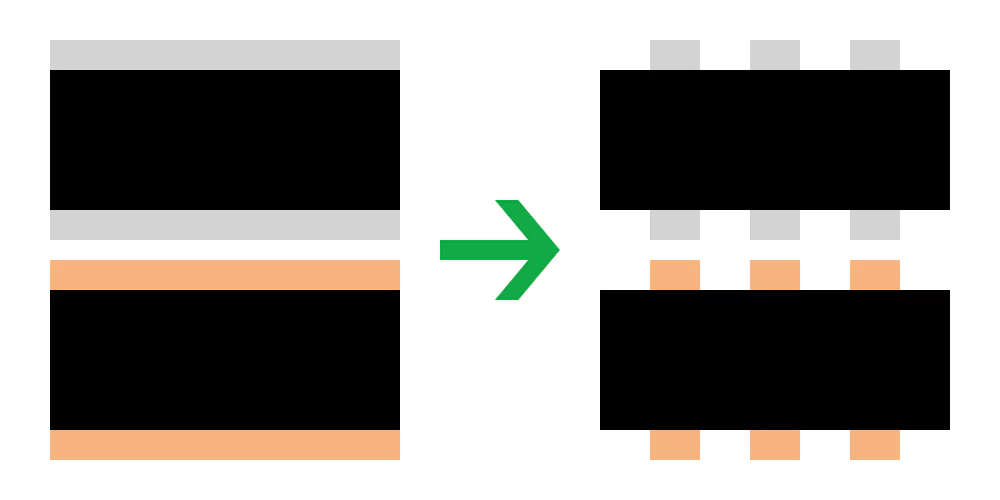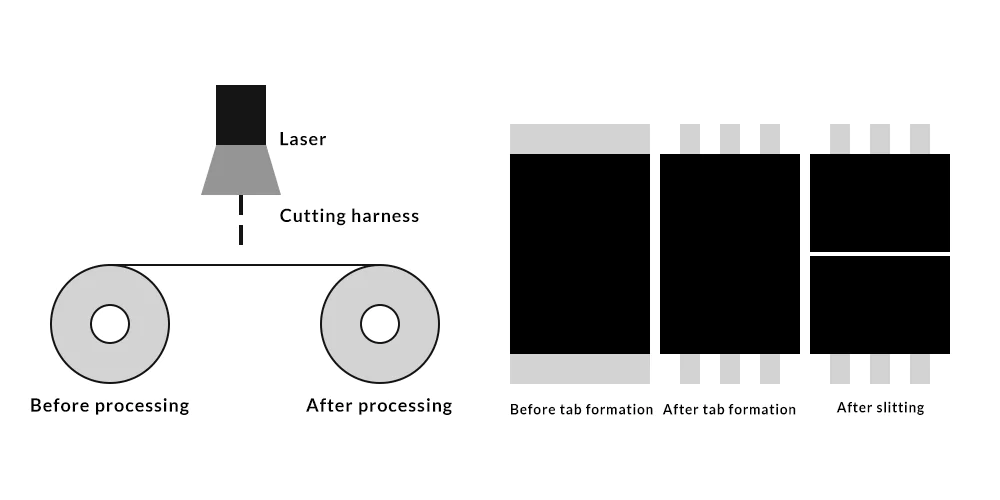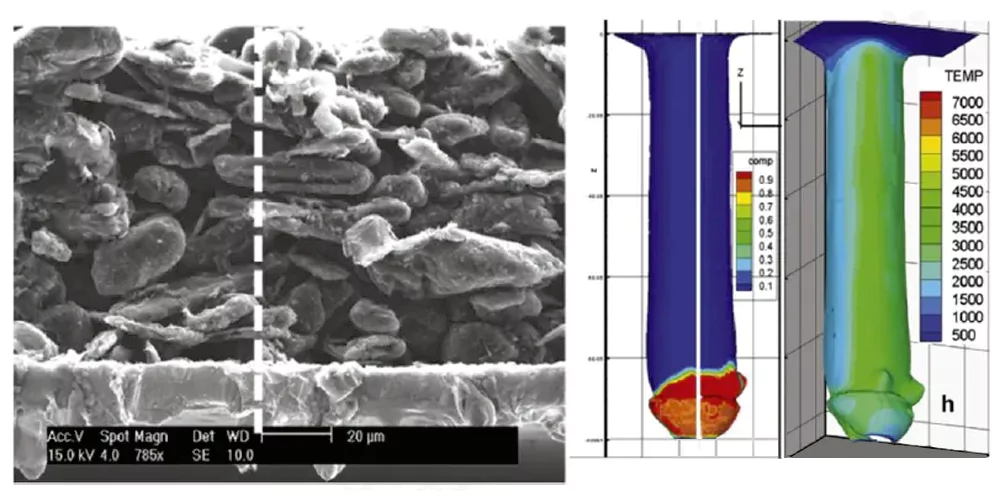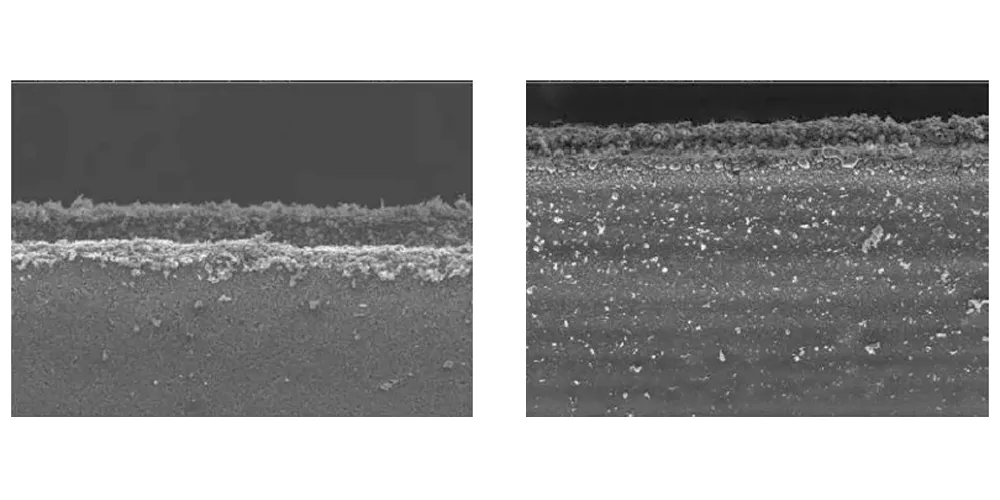In the cutting process, issues such as rapid mold wear, long mold change times, poor flexibility, and low production efficiency often lead to unstable processes, resulting in inconsistent electrode cutting quality and reduced battery performance. Laser cutting, due to its advantages of no vibration deviation, high precision, good stability, and no need for mold replacement, has gradually become mainstream in lithium battery manufacturing. It is commonly used in processes such as tab cutting, electrode sheet slitting, and separator slitting.
Characteristics of Battery Electrode Die Cutting Machine:
1. Excessive, insufficient, or uneven cutting gaps can cause burrs.
2. Dull or damaged cutting edges can produce burrs.
3. Improper cutting conditions, such as poor contact between the workpiece and the punch or die, or improper positioning height during trimming and punching, can also cause burrs if the workpiece height is lower than the positioning height, resulting in poor fit between the workpiece shape and the cutting edge.
4. Mold temperature rise during operation can cause gap changes, leading to burrs on the cut electrode sheets.
Characteristics of Battery Electrode Laser Cutting Machine:
1. Narrow cutting gaps.
2. Small heat-affected zone near the cutting edge.
3. Minimal local deformation.
4. Non-contact cutting, clean, safe, and pollution-free.
5. Easy integration with automated equipment, facilitating process automation.
6. No restrictions on cutting workpieces; laser beams have profiling capabilities.
7. Integration with computers, saving materials.
Given the significant safety hazards posed by burrs from mechanical die cutting in power batteries, laser cutting is expected to be the primary method in the future.

Figure 1: Die Cutting
Principle of Laser Cutting:
A focused high-power density laser beam irradiates the battery electrode sheet to be cut, rapidly heating it to a high temperature, causing it to melt, vaporize, ablate, or reach the ignition point, forming holes. As the beam moves across the sheet, these holes form a continuous narrow cut, completing the cutting of the electrode sheet.

Figure 2: Schematic Diagram of Laser Cutting Principle
Main Process Parameters of Laser Cutting:
①Beam Mode:
The lower the beam mode, the smaller the focused spot size, the higher the power density and energy density, the narrower the cut, and the higher the cutting efficiency and quality.
②Polarization of the Laser Beam:
Like any type of electromagnetic wave transmission, a laser beam has electric and magnetic vector components that are perpendicular to each other and to the direction of beam propagation. In optics, the electric vector is considered the polarization direction of the laser beam. When the cutting direction is parallel to the polarization direction, the cutting front absorbs the laser most efficiently, resulting in a narrow cut, low cut perpendicularity and roughness, and high cutting speed.
③Laser Power:
Laser cutting requires the laser beam to be focused to the smallest spot diameter with the highest power density. The laser power required for cutting mainly depends on the cutting type and the properties of the material being cut. Vaporization cutting requires the highest laser power, by melting cutting, and oxygen-assisted melting cutting requires the least.
Average power calculation formula:
Average power = Single pulse energy×Repetition frequency
Peak power calculation formula:
Peak power = Single pulse energy / Pulse width
④Focus Position:
The focal plane above the workpiece is positive defocus, and below the workpiece is negative defocus. According to geometric optics theory, when the positive and negative defocus planes are equidistant from the processing surface, the power density on the corresponding planes is approximately the same.
⑤Laser Focal Depth:
The focal depth of the focusing system significantly affects laser cutting quality. If the focal depth of the focused beam is short, the focusing angle is large, and the spot size changes significantly near the focus, the laser power density on the material surface will vary greatly with different focus positions, greatly affecting the cutting. For laser cutting, the focus position should be on or slightly below the workpiece surface to achieve the maximum cutting depth and the smallest cutting width.
Since lithium-ion battery electrode sheets have a double-sided coating + middle metal current collector layer structure, and the properties of the coating and metal foil differ greatly, their responses to laser action also differ. When the laser acts on the negative graphite layer or positive active material layer, due to their high laser absorption rate and low thermal conductivity, the coating requires relatively low laser energy for melting and vaporization. In contrast, the metal current collector reflects the laser and has fast thermal conduction, so the laser energy required for melting and vaporization of the metal layer is higher.

Figure 3: Copper Composition and Temperature Distribution in the Thickness Direction of a Single-Sided Coated Negative Electrode Under Laser Action
Figure 3 shows the copper composition and temperature distribution in the thickness direction of a single-sided coated negative electrode under laser action. When the laser acts on the graphite layer, the graphite mainly vaporizes due to its material properties. When the laser penetrates the copper foil, the foil begins to melt, forming a molten pool. If the process parameters are inappropriate, problems may occur: (1) Coating peeling at the cut edge, exposing the metal foil, as shown in the left image of Figure 4; (2) A large amount of cutting debris around the cut edge. These issues can lead to reduced battery performance and safety quality problems, as shown in the right image of Figure 4. Therefore, when using laser cutting, it is necessary to optimize the process parameters based on the properties of the active material and metal foil to ensure complete cutting of the electrode sheet and good cut edge quality without leaving metal debris.

Figure 4: Cutting Edge Issues: Exposed Metal Foil and Cutting Debris
Improvement Directions for Laser Cutting:
1. Cutting Efficiency: The current level of 60-90 m/min will continue to improve, with an expected level of 120-180 m/min within three years.
2. Cutting Quality: Currently, laser cutting cannot be directly used on ternary cathode material areas. Future advancements in new laser types and laser processes may enable laser cutting of ternary cathode materials. Additionally, cutting quality issues such as heat-affected zones, burrs, and molten beads can be improved through mechanical stability and laser process enhancements.
3. Equipment Stability: This includes improving the stability of the equipment itself by increasing operational availability and optimizing loading and unloading times to enhance overall equipment effectiveness (OEE) and mean time between failures (MTBF). It also involves improving product quality consistency by enhancing the process capability index (CPK).
4. Intelligence: Achieving single-machine intelligence and then full-line intelligence. Integrating online detection, PLC control, and upper computer control for single-machine intelligence. Then, by connecting to factory information systems and optimizing single-machine data collection, achieving full-line intelligence.